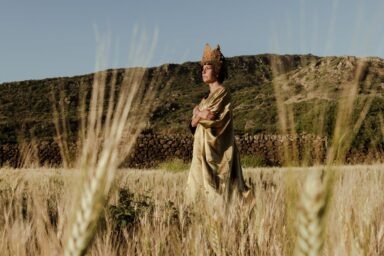We pay homage to the groundbreaking portrait and fashion photographer whose unexpected disappearance left an overwhelming emptiness in the international community
Text by: Gilda Bruno
Cover image courtesy @ Giovanni Gastel, Angeli Caduti Exhibit, 2015
“For decades, Giovanni Gastel has worked on the pleasure of transforming his gaze upon the world into a double that has always oscillated between the dream of the industrial product and the appearance of the sensual body,” said Germano Celant about the work of the Milanese genius in his dedicated book Giovanni Gastel: Masks and Ghosts (2009).
“By extolling the pleasant and seductive elements of appearance, Gastel has discovered that in order for life energy to exist it must have a mortal counterpart,” further explained the author. “It is in this dialectic between figure and shadow, appearance and phantasm that the game of enchantment and glamour dies, making room for the revolting and the disgusting that Gastel aspires to transform, however, into another image of the sublime.”

Germano Celant by Giovanni Gastel, Gastel the People I Like, © Skira Editore, 2020.
One of the most precious personalities of this century, Giovanni Gastel, the internationally acclaimed photographer who contributed to the birth of the Italian fashion imagery, died at the Fiera di Milano hospital on March 13th due to COVID-19-related complications. Despite being most widely recognised for his portraits of celebrities, Gastel’s conception of the photographic medium was one of a kind, as demonstrated by his lesser-known series Flowers, Metamorphosis, Fallen Angels, and Nymphs — heartfelt tributes to his visionary, often otherwordly, representation of the world and its fascinating protagonists.
“I have caught a glimpse of life while running and the memory now presents it to me broken down into paintings, events, and people who appear and disappear as it happens in dreams,” wrote the photographer in his autobiographical book An eternal instant. My life (2016). Retracing Gastel’s path to success, from his early childhood to his most recent achievements, the biography revealed the hidden traits of the artist’s personality, permeated with silent suffering and extraordinary sensitivity: two features that made him feel like “a stranger to the world and its stories” while also turning him into one of the most profound photographers of our times.
As a matter of fact, Gastel never let the fame achieved within the fashion scenario cloud his deeply-rooted desire to pursue a more purely artistic type of photography, where he could experiment with “old mix” techniques, cross processing, pictorial elaborations, decouplings and stratifications, as well as digital editing. “I hope that all my works survive their momentary function to become works of art in their own right,” said Gastel in one of his last interviews exactly a month ago: a statement that, given the tragic events of last week, already sounds like a testament to his cultural legacy through the years.
The visual talent’s first art exhibition took place at the Triennale di Milano in 1997 with the curatorial support of Germano Celant himself, former senior curator at New York’s Guggenheim and director of Milan’s Prada Foundation who, just like him, passed away after contracting the virus last April. The nephew of Italian motion-picture director Luchino Visconti, Gastel was born in Milan in 1955 to Giuseppe Gastel and Ida Visconti di Modrone and was the last of seven children.
His success was not long in coming: already at 20, Gastel secured himself a commissioned job at Christie’s, a prestigious British auction house based in London. In 1981 he met Carla Ghiglieri: the agent who launched him into the fashion world, where he contributed to agenda-setting magazines such as Vogue Italia, Mondo Uomo, and Donna. From then onwards, Gastel’s photography work went hand in hand with the exponential rise of the Made in Italy label, as the photographer ventured himself into the creation of campaigns for some of the most renowned Italian fashion houses — from Krizia to Versace, Missoni, Tod’s, Trussardi, Ferragamo and more.

Mimmo Paladino by Giovanni Gastel, Gastel the People I Like, © Skira Editore, 2020.
Gastel’s contribution to the fashion community did not only serve as an incomparable documentation of the shaping of Italian fashion as we know it today; yet, the photographer’s devotion to his profession also revolutionised the fashion industry by creating space for a more sincere collaboration between the models being photographed and the person standing behind the camera.
“COVID-19 even snatched Giovanni Gastel from us,” Italy’s Minister of Culture Dario Franceschini said in a press release after learning about the Master’s disappearance. “Italian photography loses a great protagonist loved and esteemed across the world. An original, polite artist with a profound aesthetic sense who, thanks to his shots, has been able to portray and capture the intimacy of the great personalities of international fashion and culture.”
Over the last twenty years, the photographer had fully dedicated himself to portrait photography, capturing subjects as influential as Barack Obama, Monica Bellucci, Ettore Sottsass, R.E.M., Marco Pannella, Johnny Depp, and Roberto Bolle: a collection of over 200 faces that culminated in his last exhibition, The People I like, which was on display at Rome’s MAXXI until March 5, 2021.
“The People I like talks about my world and about those who have passed on something to me, taught me something new, and touched my soul,” Gastel explained last year in the introductory video to the showcase. “For me, this does not depend on someone’s origin, social background, group of belonging, or such. The soul is something unique that cannot be affected by any of these factors and that, just like the heart, does not follow any predefined pattern.”
The “photographer of lost souls,” as Italian musician Piero Pelù recalled him in an Instagram post on the day of his passing, will be remembered for his innate talent and kindness: two gifts that graced the life and work of the generations of creatives, intellectuals, and fashion idols who had the luck to meet him and receive his support.
Quoting Gastel’s farewell message to entertainment photographer Efrem Raimondi, “When a true friend dies, who is also an extraordinarily talented colleague, many pains are mixed in the heart. The pain for the departed friend, the pain for the loss of one of the most beautiful and lucid brains in our sector, and the pain for what his talent could still have given to the world.”


